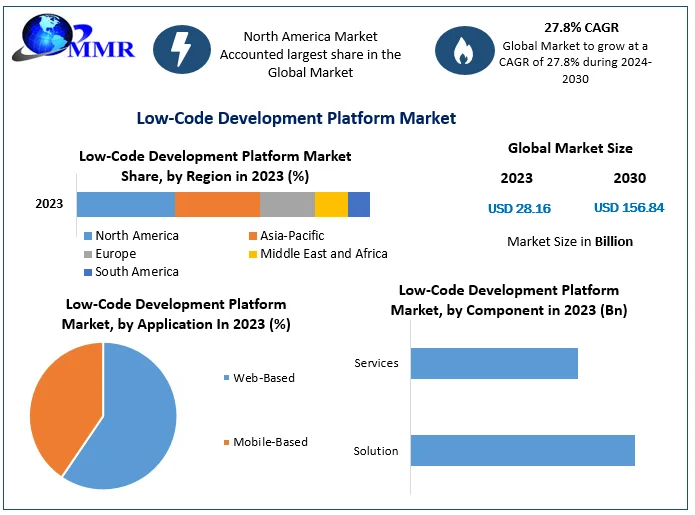Great Facts For Choosing Low-code platforms for application development
Great Facts For Choosing Low-code platforms for application development
Blog Article
Advantages Of Low Code Application Development For Non-Developers
The following key factors make low-code development available to non-developers.
Drag-anddrop Builders: Lowcode platform have drag-and-drop interfaces that enable non-developers to create visually appealing applications, without having to code. The process of developing applications is now more accessible for those who have no technical background.
WYSIWYG: WYSIWYG editors are "What you See is What you Get" editors that let users to design workflows and interfaces similar as the final product. It makes it much simpler to understand and use.
Simple Logic and Workflow
Visual Workflow Modeling - Users are able to develop business procedures and logic applications by using visual flowcharts or models. This is much more intuitive than traditional programming methods.
Low-code platforms typically have pre-built logic elements (e.g. conditionsal statements loops) that are easily configured, reducing the requirement for complicated coding.
Reusable components and templates:
Templates for libraries of pre-built templates Numerous low-code platforms have libraries of the most commonly used types of applications, providing non-developers a solid base to build upon and then customize.
Reusable widgets and Modules by using modules or widgets that can be reused users can streamline the creation process by cutting down on the need for detailed technical knowledge.
Tutorials for Guided Development and Guided Development:
Step-by-step guide: Platforms offer tutorials, on-screen tips, and a set of development steps to assist non-developers in creating applications.
Interactive Tutorials Interactive tutorials are hands-on and interactive that allow users to learn through doing. This increases their confidence in the platform.
Integration of existing tools:
Seamless Integrate: Low code platforms are built to integrate seamlessly with existing tools and systems in the business (e.g. the ERP or CRM) that permits non-developers to build applications that can work within existing workflows.
APIs Connectors: APIs integrate into apps to facilitate integration. This allows non-programmers, who do not have coding abilities, to connect to external services.
Collaboration Features:
Team Collaboration - Features like real-time team collaboration and shared workspaces help non-developers collaborate with analysts, professionals, analysts, and stakeholders.
Access Control Based on Roles: Users who do not develop can be assigned roles and access levels that permit them to contribute without compromising functionality or security.
Automated Tests and Debugging
Built-in Testing Tools: Platforms that are low-code often come with built-in testing and debugging tools that automate these procedures, making it simpler for non-developers to make sure the application is working properly.
Error Highlighting When errors occur the platform highlights them and suggests solutions. It assists non-developers with finding solutions.
The general rule is that low-code app development has the ability to democratize development. This is a major advantage for non-developers. Low-code applications allow business users to be involved in the creation and development of apps by offering visual tools and a guided experience. This bridges the gap between business and technical demands. Have a look at the most popular more help on Low-code Platform for application development for more advice including application development platforms, app modernisation, ms azure sql, app modernisation, build with docker, database in azure, application modernization software, app modernization, push notifications android, paas service and more.
Flexibility And Scalability Are Two Advantages Of Low Code Application Development
Low-code application creation offers several advantages, particularly in terms of scaleability. It is essential to develop applications that develop with your business and adapt to evolves. Here are the major benefits:
Cloud-based deployment. Many low-code platforms feature a cloud-based implementation that allow them to scale applications seamlessly with cloud infrastructure. This enables businesses to manage increased loads without worrying about the management of servers.
Auto-Scaling Feature: Built-in features that automatically increase resources to satisfy demand, ensuring consistent performance with no manual inputs in peak hours.
Flexible Architecture:
Modular design: Low-code platforms are a great way to promote modular software. This allows components to be designed and developed on their own as well as tested, sized and so on. Modularity provides greater flexibility and makes it possible to modify or expand specific components of the application without impacting other parts.
Integration of microservices: The support for microservices architecture allows applications to be built as a collection of loosely linked services. This improves capacity and flexibility.
Customizable Solution:
Extensibility : Low-code platforms allow developers to enhance functionality beyond the standard features. This allows businesses to satisfy the requirements of their particular business.
Third-Party Integrations: Companies are able to incorporate additional functions and services into their apps by integrating with APIs and third-party services.
Agile Development and its deployment
Continuous Delivery and Deployment Low-code Platforms can support agile methods by enabling continuous Integration and Continuous Delivery (CI/CD). This allows for rapid deployment and updating of new features.
Iterative Development: The nature of low-code development ensures applications are able to be incrementally improved and scaled, reducing the risks of large-scale changes and allows for more controlled growth.
Resource Optimization
Efficiency in Resource Management: Low-code systems assist optimize the usage of resources through providing tools for monitoring and managing application performance. This ensures resources are used effectively and can be scaled to meet actual needs.
Load Balance: This feature lets the application manage massive traffic by distributing workloads among several servers. It also ensures the application's performance is constant.
Global Reach
Multi-Region: Platform deployments that use low-code are frequently accessible across multiple countries, allowing businesses to provide low latency access to every user. This is particularly important for applications with a worldwide user base.
Support for Localization Built-in support for localization lets the software be easily customized to suit various languages and needs in diverse markets.
Maintenance and Updates
Simplified Maintenance: The aesthetic and modular design of low-code programs simplify maintenance tasks making it possible for bugs and updates to be made quickly, without extensive downtime.
Version Control: Integrated versions control systems permit the safe deployment of updates and rollbacks. Previous versions can also be restored in the event that they are needed.
Cost Efficiency:
Low development costs. Through the reduction of coding requirements, low-code platform platforms lower the development cost and allow applications to scale up without requiring more development effort.
Pay-As-You-Go Models - A lot of low-code applications have flexible pricing models such as pay-as you-go that is based on actual usage, growth as well as financial flexibility.
The flexibility of low-code apps permits businesses to create robust flexible, scalable, adaptable and robust applications. These platforms allow rapid changes to meet changing demands and efficient utilization of resources and continual advancement. Applications can grow and evolve with the needs of the business. View the best advice about Legacy application modernization with Low-code for blog advice including cross platform mobile dev, develop web application, rad development, driver jdbc, driver jdbc, sso azure, lowcode no code, develop web application, stored sql procedures, multiplatform mobile app development and more.
The Benefits Of Low-Code Programming For Developing Applications, In Terms Of The Limitations And The Possibility Of Customization
Low-code development provides an unbiased approach to dealing with issues, while allowing the possibility of customizing. These are the major advantages: Resolving Limitations
: .
Low-code platforms make development easier by providing templates that are pre-built and other components. This allows rapid deployment and development of complicated applications.
A lot of platforms offer guided workflows, which assist developers to navigate through complex procedures. They minimize the risk of error and maintain consistency.
Scalability Solutions
Built-in Scalability: Low-code platforms include many features that support an architectural design that is scalable, allowing the applications to handle increased load without significant redevelopment.
Performance Monitoring: The integrated tools for performance monitoring and optimization help ensure that applications are efficient as they expand.
Security and Compliance
Integrated Security Features: Low-code systems have security features built-in like encryption, role-based access control, and automated compliance checks that address common security concerns.
Platforms regularly update their security and compliance measures to ensure that their applications are safe from new threats.
Customization Features:
Extensibility:
Custom Code Integration: Low-code systems typically allow the integration of custom code (e.g., JavaScript, Python) that allows developers to expand the capabilities beyond what is available in the standard features.
Custom Modules and plugins: Developers have the option of designing custom modules or plugins in order to customize specific functionality to meet specific business requirements.
APIs and Integration
API Support: The extensive support for APIs allows seamless integration with other systems and services. This allows for extensive customization and connectivity.
Third-Party Applications Lowcode platforms usually come pre-built with connectors for third-party applications, which makes it simpler to integrate them and personalize the app.
Flexible UI/UX Design
Customizable Interfaces: Developers have the ability to design and customize user interfaces in line with specific branding and usability requirements, resulting in a customized user experience.
Responsive Design Built-in features of responsive design guarantee that apps can be adapted to different devices and screen sizes.
Business Logic Customization
Visual Workflow Builders - Visual tools that allow you to design and customize workflows, business logic and processes enable developers to develop intricate and custom processes with no lengthy programming.
Platforms come with conditional Logic, which allows for the development of custom scripts designed to deal with specific scenarios and business rules.
Data Management
Custom Data Models: Developers may develop custom data models that meet specific requirements of an application, ensuring that data handling is custom-made to meet the needs of business.
Advanced Data Processor: The combination of advanced data processing tools and capabilities allows for the modification of the way data is processed and analysed within the application.
How to balance customisation with limitations:
Frameworks and Standards
Low-code platforms encourage the use of industry-standards and best practices. This results in applications of high-quality that are scalable and safe.
Governance Frameworks: Integrated governance frameworks ensure that any modifications don't interfere with the integrity, compliance, or the security of an application.
Iterative Development:
Rapid Prototyping: The capability to quickly prototype and test modifications allows developers to iterate based on user feedback, refining the application to meet the needs of users.
Low-code platforms facilitate constant improvement through the continuous improvement of their design and enhancements as requirements for business change.
User Empowerment
Giving Citizen Developers the tools they need by allowing non-developers to make customizations through simple interfaces, low-code platforms increase the pool of contributors who can customize and enhance applications.
Support and training: A lot of platforms include extensive training resources as well as support services to help users in making modifications that are effective without affecting the performance or stability.
Overall, low code application development provides a robust framework to address limitations and provide ample options for customization. This balance allows companies to develop and maintain applications that are both functional and adapted to meet specific business requirements. All while keeping high-quality, security, scalability, and standards.